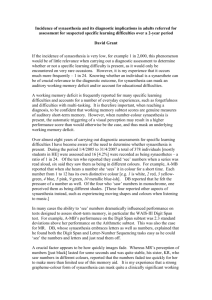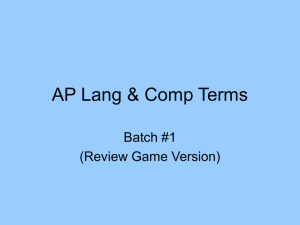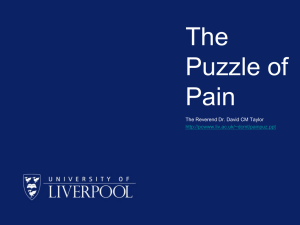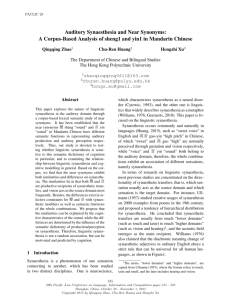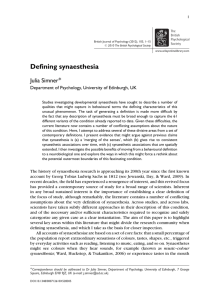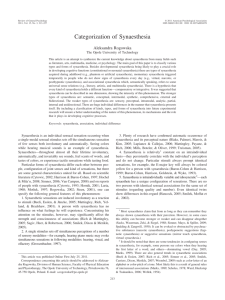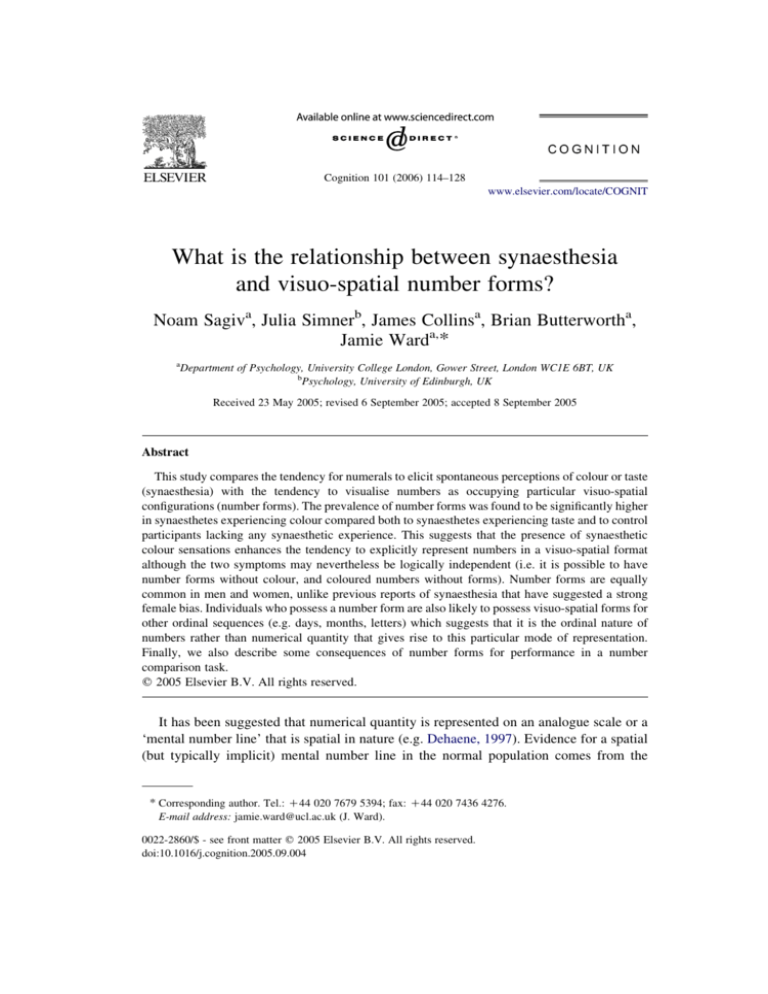
Cognition 101 (2006) 114–128
www.elsevier.com/locate/COGNIT
What is the relationship between synaesthesia
and visuo-spatial number forms?
Noam Sagiva, Julia Simnerb, James Collinsa, Brian Butterwortha,
Jamie Warda,*
a
Department of Psychology, University College London, Gower Street, London WC1E 6BT, UK
b
Psychology, University of Edinburgh, UK
Received 23 May 2005; revised 6 September 2005; accepted 8 September 2005
Abstract
This study compares the tendency for numerals to elicit spontaneous perceptions of colour or taste
(synaesthesia) with the tendency to visualise numbers as occupying particular visuo-spatial
configurations (number forms). The prevalence of number forms was found to be significantly higher
in synaesthetes experiencing colour compared both to synaesthetes experiencing taste and to control
participants lacking any synaesthetic experience. This suggests that the presence of synaesthetic
colour sensations enhances the tendency to explicitly represent numbers in a visuo-spatial format
although the two symptoms may nevertheless be logically independent (i.e. it is possible to have
number forms without colour, and coloured numbers without forms). Number forms are equally
common in men and women, unlike previous reports of synaesthesia that have suggested a strong
female bias. Individuals who possess a number form are also likely to possess visuo-spatial forms for
other ordinal sequences (e.g. days, months, letters) which suggests that it is the ordinal nature of
numbers rather than numerical quantity that gives rise to this particular mode of representation.
Finally, we also describe some consequences of number forms for performance in a number
comparison task.
q 2005 Elsevier B.V. All rights reserved.
It has been suggested that numerical quantity is represented on an analogue scale or a
‘mental number line’ that is spatial in nature (e.g. Dehaene, 1997). Evidence for a spatial
(but typically implicit) mental number line in the normal population comes from the
* Corresponding author. Tel.: C44 020 7679 5394; fax: C44 020 7436 4276.
E-mail address: jamie.ward@ucl.ac.uk (J. Ward).
0022-2860/$ - see front matter q 2005 Elsevier B.V. All rights reserved.
doi:10.1016/j.cognition.2005.09.004
N. Sagiv et al. / Cognition 101 (2006) 114–128
115
SNARC effect-the Spatial-Numerical Association of Response Codes (Dehaene, Bossini,
& Giraux, 1993). If participants are asked to make number judgements of parity (i.e. odd
or even) about the numbers 1–9 then they are faster at making judgements about small
numbers (!5) with their left hand and faster at making judgements about larger numbers
(O5) with their right hand. Hence, participants perform as if reliant on a spatially-based
mental number line running from left to right. In addition, it has been shown that passive
viewing of numbers can induce spatial shifts of attention (Fischer, Castel, Dodd, & Pratt,
2003) and that spatial attention deficits can bias numerical judgments (Vuilleumier,
Ortigue, & Brugger, 2004).
For most people, the mental number line is implicit insofar as it can only be detected
indirectly through behavioural manipulations rather than directly via conscious report.
However, a proportion of the population do report consciously visualising numbers in
spatial arrays (Seron, Pesenti, Noel, Deloche, & Cornet, 1992). Galton (1880c)
documented the first known examples of these ‘number forms’ and introduced this
terminology to describe them. In the current study, we examine this phenomenon, and
have five aims. The first is a purely empirical question, in which we aim to ascertain the
prevalence and characteristics of number forms in the general population. The second aim
is to examine whether or not there is a relationship between the tendency to experience
anomalous colour sensations with numbers (i.e. number-colour synaesthesia) and the
tendency to report number forms. The results may have important theoretical implications
for understanding the origin of cross-modal contributions to numerical representation. Our
third aim is to consider other ordinal sequences (alphabet, days and months), to address the
theoretical question of whether number forms are related to numerical quantity or, more
generally, to ordered sets. Next, we provide objective behavioural measures to support
these subjective reports. Finally, we consider the phenomenology of number forms in
more detail, asking whether the phenomenon should be considered a type of synaesthesia.
A number of studies have attempted to estimate the prevalence of number forms as is
summarised in Table 1. Despite discrepancies in these estimates, all point to the fact that
number forms are by no means exceptionally rare. Prevalence estimates in children have
not been studied in detail but both Galton (1880a) and Peabody (1915) cite a prevalence
rate of 25% in male schoolboys. Some of these studies measured the prevalence of
‘visualised numerals’ and, as such, did not make a critical distinction between space and
colour. But, a number of studies have drawn attention to the additional presence of number
Table 1
Prevalence estimates for number forms in adult samples
Study
N
Overall (%)
Male (%)
Female (%)
(Galton, 1880b)
Patrick (1893)a
Flournoy (1893)a
Calkins (1895)
Phillips
(1896–1897)
Seron et al. (1992)
–
–
370
979
2009
5.0
16.7
11.1
–
7.3
3.3
–
–
–
6.9
6.7
–
–
12.0
7.7
194
14.2
14.6
13.7
a
Cited in Philips (1896–1897).
116
N. Sagiv et al. / Cognition 101 (2006) 114–128
forms in people with grapheme-colour synaesthesia (e.g. Baron-Cohen, Wyke, & Binnie,
1987; Collins, 1929; Ginsberg, 1923; Odgaard, Flowers, & Bradman, 1999; Ostwald,
1964; Wheeler & Cutsforth, 1921). These studies raise the possibility that number forms
and colour association may have common origins. Others have gone as far as to say that
number forms are a type of synaesthesia in their own right, whether coloured or not
(Cytowic, 1989; Grossenbacher & Lovelace, 2001). Indeed, the phenomenology of
number forms shares many features with synaesthetic colour associations: automaticity,
idiosyncrasy, within subject consistency across time, and concreteness of the experience.
However, conclusions about the possible association between number forms and
synaesthetic experiences of colour are difficult to draw from the small number of single
cases that have been reported. We aim to redress this shortfall with a systematic study.
1. Experimental investigation
1.1. The prevalence of number forms in synaesthetes and non-synaesthetes
1.1.1. Method
Participants fell into two broad groups: synaesthetes (NZ114) and non-synaesthete
controls (NZ311; 88 male, 223 female). The controls were recruited from the University
of Edinburgh student population, and each had participated in a stage of screening to
ensure they had no synaesthetic experiences of colour, taste, etc. (To avoid circularity we
were agnostic about whether number forms should be considered a type of synaesthesia or
not). The synaesthetic participants were recruited through our web site (www.syn.ucl.ac.
uk). Each reported synaesthetic sensations of either colour or taste in response to linguistic
stimuli, including numbers and letters. One hundred of these were colour synaesthetes, of
whom 78 were female and 22 were male (a ratio of 3.5:1), and whose mean age was 38.8
years (rangeZ11–80). The remaining 14 were lexical-gustatory synaesthetes with no
experiences of colour (Ward & Simner, 2003; Ward, Simner, & Auyeung, 2005),
including 11 females and three males (a female–male ratio of 3.6:1), with a mean age of
40.5 years (rangeZ27–53). The inclusion of synaesthetes experiencing taste enables us to
determine whether there is a relationship between number forms and synaesthesia in the
broadest sense, or whether there is a specific relationship with colour.
There were two stages of testing. The first aimed to establish the genuineness of our
synaesthete group, using measures of internal consistency. Consistency over time has
traditionally been used as a hallmark of genuineness (e.g. Baron-Cohen, Wyke, & Binnie,
1987) and our analyses compared the consistency of our synaesthetes to a group of our
controls. Synaesthetes were given a list of letters (NZ26), numerals (NZ10), days (NZ7)
and months (NZ12) and asked to note any synaesthetic associations. This was repeated
after a delay of at least 2 months in order to assess internal consistency. These values were
compared to those of 62 participants randomly selected from our control group. Fortyeight of these were asked to free associate colours to the same stimuli, and 14 were asked
to associate tastes. Both control groups were re-tested at an interval of 2 weeks, and in this
way we ‘stack the deck’ against our synaesthete participants in order to test them more
conservatively (e.g. Ward & Simner, 2003).
N. Sagiv et al. / Cognition 101 (2006) 114–128
117
In the second stage of testing, both synaesthetes and controls were probed for the
presence of number forms. All participants were asked to complete a detailed
questionnaire examining various aspects of their cognition (e.g. other anomalous
experiences, influences on their synaesthesia). For our purposes, we are interested in
those questions that asked participants about the presence of forms for numbers, letters,
days and months. These questions took the form: ‘Do you think about numbers
[letters/days/months] as being arranged in a specific pattern in space?’ Responses were
given on a five point Likert scale (strongly agree, agree, neither agree nor disagree,
disagree, strongly disagree). For any response in the affirmative, participants were asked to
draw their forms. As with consistency, the reliability of number forms was assessed on a
second occasion by asking those with number forms to draw or describe them.
1.1.2. Results
The synaesthetes reporting colour associations were 91.4% consistent over time
(SDZ10.1) compared to 33.4% for the control sample (SDZ14.3; t(146)Z28.47,
P!0.001). Equally, the taste synaesthetes were more consistent (86.2%, SDZ7.2%) than
their controls 31.4% (SDZ14.7), and this difference, too, was significant (t(25)Z10.78,
P!.001). These scores show that our synaesthete sample resembles others reported in the
literature, and provides objective evidence that they are genuinely different from control
participants.
The prevalence of number forms in the control sample and the synaesthetic groups is
shown in Fig. 1. Synaesthetes who experience colour are more likely to report the presence
of number forms compared to controls who do not experience colour (c2(1)Z99.86,
P!0.001) and to synaesthetes who experience taste (c2(1)Z6.99, P!0.01). There is no
difference in the reported proportion of number forms between taste synaesthetes and nonsynaesthetic controls (c2(1)Z1.46, N.S.), although it is to be noted that the sample size is
smaller. These data are consistent with the hypothesis that synaesthesia may enhance the
Fig. 1. The prevalence of number forms in synaesthetes and controls who report no colour or taste experiences
with numbers or other stimuli (M, male; F, female).
118
N. Sagiv et al. / Cognition 101 (2006) 114–128
visualisation of number forms, but that the phenomenon is restricted to synaesthetic
experiences of colour.
Contrary to the reports of Galton (1880b), but similarly to the findings of Seron et al.
(1992), we found that number forms were equally as common in men and women, and that
this applied to both colour synaesthetes (c2(1)Z0.25, N.S.), and controls (c2(1)Z0.06,
N.S.). This stands in contrast to the female–male ratio found in other studies of
synaesthesia that has been reported to be as high as 5.5–1 (Baron-Cohen, Burt,
Smith-Laittan, Harrison, & Bolton, 1996), 2.5:1 (Cytowic, 1989) or 3.5:1 in the present
study. We return to this point in the general discussion.
The general visuo-spatial characteristics of the number forms exhibited by the
synaesthetes and controls are shown in Table 2 with some examples drawn in Fig. 2. The
forms were classified according to their overall direction (considering the digits 1–100)
and the direction for the first 10 digits. In addition, we tabulated the number of instances in
which the form was continuous or discontinuous (i.e. whether there were breaks in the
number line in which the line stops and restarts at another position in space) and for the
continuous forms, whether they existed as a straight line or contained curves, bends or
undulations. Some research has shown that, in the non-synaesthetic population, numbers
may be grouped into tens (Nuerk, Weger, & Willmes, 2001). In a follow up interview of a
subset of participants with number forms (30 synaesthetes and 12 controls), we also
attempted to ascertain whether the number form exists in peripersonal space (e.g. ‘starts
5 in. from my face and 1 in. above eye-level’) or in imaginal space (or ‘mind’s eye’) that is
not specified in coordinates relative to the body. In terms of qualitative characteristics,
colour synaesthetes do not differ from controls in terms of direction (c2(4)Z1.55, N.S.) or
Table 2
Qualitative characteristics of number forms
Direction
Left–right
Right–left
Bottom–top
Top–bottom
Circle/spiral
Other
Spatial reference frame
Peripersonal (out-of-body)
Imaginal (mind’s eye)
Shape
Straight line
Continuous but not straight
Discontinuous
Colour synaesthetes
Controls
Overall
Initial
Overall
Initial
(1–100)
(1–10)
(1–100)
(1–10)
70
9
11
0
2
9
100%
Colour synaesthetes
37
63
100%
Colour Synaesthetes
63
23
14
100%
63
5
18
0
4
11
100%
55
5
23
0
0
18
100%
Controls
58
42
100%
Controls
91
5
5
100%
68
5
23
0
0
5
100%
N. Sagiv et al. / Cognition 101 (2006) 114–128
119
Fig. 2. Examples of number forms from our sample (the colours are not shown).
position in space (c2(1)Z1.64, N.S.), but there is a trend for synaesthetes to report more
convoluted shapes (c2(1)Z6.17, P!.05).
1.2. Are visuo-spatial forms found for other ordinal sequences?
One reason why numbers may be amenable to this type of representation is that they are
an ordered set. If it is the ordinal nature of numbers, rather than numerical size, that gives
120
N. Sagiv et al. / Cognition 101 (2006) 114–128
Fig. 3. Venn diagrams showing the prevalence of visuo-spatial forms for numbers, time (Zdays and/or months)
and letters of the alphabet for colour synaesthetes and controls (%).
rise to a visuo-spatial format of representation then we might expect other types of ordinal
sequences to be represented in this way (e.g. letters of the alphabet and units of time).1
Indeed, Gevers, Reynvoet, & Fias (2003) have found a SNARC-like effect in the nonsynaesthetic population for months and letters of the alphabet, with earlier months and
letters being leftmost. Fig. 3 shows the occurrence of visuo-spatial forms for numerals,
letters of the alphabet and time (days and/or months) for our two populations, and provides
the following information. First, we see that mental representations of letters and time are
also commonly found in synaesthesia, the prevalence rates being 71% (controlsZ15.1%)
and 76% (controlsZ20.0%), respectively. Second, it appears that if a synaesthete has one
type of form then there is a very strong tendency for them to also have at least one other
type of form (as seen from the high overlap in the Venn diagram). The same holds true for
1
The most extraordinary case of visuo-spatial forms, to date, is CS (Cytowic, 2002). She reported forms for
numbers, months, shoe sizes, height, historical time periods, time of day, TV stations and body temperature, to
name a few.
N. Sagiv et al. / Cognition 101 (2006) 114–128
121
the non-synaesthetes and the synaesthetes that experience taste (the three taste
synaesthetes who report number forms all report forms for letters, days and months),
the difference being simply that the phenomenon, overall, is less common in these latter
groups. We might conclude, then, that visuo-spatial forms are related to ordinal
representations rather than number in particular. Indeed similar suggestions have been
made with respect to inducers of synaesthetic colour (e.g. Shanon, 1982).
This is in contrast to Walsh’s (2003) recent suggestion that space, time, and numbers
are linked via a single general magnitude system. While numbers and time are
conceptualised in terms of magnitude and order, letters of the alphabet do not carry
magnitude information and do not easily fit Walsh’s formulation. Nevertheless, the extent
to which order and magnitude share common mechanisms is still a matter of debate (e.g.
see Turconi, Jemel, Rossion, & Seron, 2004). The present conclusion may accord with an
extended framework addressing both magnitude and order.
1.3. Behavioural correlates of number forms
While the findings reported so far suggest that number forms are not confabulatory in
origin, we next considered whether the presence of such peculiar spatial representations
shows itself with behavioural measures. To document how number forms affect
performance we used a spatial congruity paradigm tailored to each participant’s number
form.
1.3.1. Methods
We tested five individuals with number forms. For each participant, we chose a linear
segment (one decade) of the number form from which pairs of numbers were drawn,
separated by a distance of either one (e.g. 6,7) or two (6,8). The two numbers were
arranged on the screen either congruently with their relative location on the number form,
or in the reverse order (an incongruent trial). Response keys were chosen such that their
relative location on the British keyboard matched the arrangement of stimuli on the screen
(horizontally or diagonally). The experiment was divided into two blocks. In one block
participants were required to judge which of the two numbers was larger, and in the other,
they decided which one was smaller. Note that by collapsing together the data from the
two tasks we avoid a handedness confound. The stimuli were 0.66 degrees tall and
presented on the screen (approximately 2.6 degrees of visual angle from fixation) until a
response was made. Each block comprised 72 trials (preceded by six practice trials)
comprising equal proportions of congruent and incongruent trials. The stimuli were
presented in pseudo-random order using E-Prime (www.pstnet.com). Each stimulus was
preceded by a fixation cross presented for 500 ms. Table 3 summarizes individual
participant’s number forms, segment and response keys used, and Fig. 4 contains a sample
trial. The results are summarized in (Fig. 5).
1.3.2. Results
Participants responded faster in congruent (684 ms) than incongruent (712 ms) trials
[t(4)Z4.0, P!0.02]. This trend was observed in all participants. Crucially, the results
were significant for S1, whose number form direction is right–left. This is in the opposite
122
N. Sagiv et al. / Cognition 101 (2006) 114–128
Table 3
Reaction time experiment specification: a schematic drawing of each participant’s number form is given, the
range of numbers used in the experiment, direction in that range, and response keys used
Participant
(age in years)
S1
(28)
S2
(53)
S3
(27)
S4
(55)
S5
(29)
Range used
Direction
21–29
1–9
11–19
1–9
21–29
Response keys
G, K
G, K
V, K
M, P
M, O
Number form
(schematic)
Fig. 4. Sample stimulus used in the behavioural experiments, showing an incongruent trial for a participant with a
diagonal number form extending from the lower left to the top right side (S4).
Fig. 5. Reaction times to congruent and incongruent trials.
N. Sagiv et al. / Cognition 101 (2006) 114–128
123
orientation to most other people with number forms and to that obtained in the general
population using the SNARC paradigm. S1 is a native English speaker and does not read in
any language written from right to left. Nevertheless, she shows a consistent preference for
placing small numbers to the right of larger ones (t(35)Z2.1, P!0.05). These results are
consistent with individuals’ subjective report and suggest that accessing numbers forms
may be involuntary.
2. General discussion
There is now a large body of empirical evidence to suggest that aspects of numerical
representation are visuo-spatial in nature (recent reviews of numerical spatial interactions
are provided by Fias & Fischer, 2005; Hubbard, Piazza, Pinel, & Dehaene, 2005).
Evidence for this comes from studies of number-space response compatibility (Dehaene,
Bossini, & Giraux, 1993) and studies of spatial attention (Fischer, Castel, Dodd, & Pratt,
2003; Zorzi, Priftis, & Umilta, 2002). Additionally, a proportion of the population
consciously report visualising numbers in a spatial array. Anecdotal reports have
previously suggested that synaesthetes often report such ‘number forms’, and our study
documents this empirically. It shows also that a higher rate of number forms in
synaesthetes is related specifically to those synaesthetes who report associations of colour.
The fact that synaesthetes are not more likely to report other unusual phenomenon
(including déjà vu and out-of-body experience; Simner et al., in prep; also Rich,
Bradshaw, & Mattingley, in press) together with the fact that taste synaesthetes do not
report a high prevalence of number forms, suggests that these results are not merely a bias
to report atypical experiences.
2.1. Why are synaesthetes more likely to report number-forms?
One explanation for the higher prevalence of number forms in colour synaesthetes is
that there may be an interaction between the general tendency to represent numbers in
spatial codes (present in us all) and, in a few individuals, the tendency for numerals to
evoke spontaneous colour experiences. That is, the presence of colours could increase
awareness of the number form that in most other individuals is only implicit. How might
this occur? A relatively parsimonious account is that existing spatial codes for numbers are
used as default locations at which the corresponding synaesthetic colours are seen.
Alternatively, synaesthetes may have better access to material that would not otherwise be
available for conscious report, as suggested by Cytowic (e.g. 2002). As such, the study of
synaesthesia may be used to reveal important cross-domain mechanisms that operate in us
all. Given that most people do not report explicit number forms it is very hard to ascertain
the precise configuration of their putative mental number line, except in the broadest of
terms (e.g. that they tend to go from left to right-as do those of the synaesthetes). One
shortfall of this idea is that it does not account for the tendency of synaesthetes’ number
forms to be slightly more convoluted.
Another explanation for the co-occurrence of numbers forms and grapheme-colour
synaesthesia is that number forms are a type of synaesthesia in their own right (e.g.
124
N. Sagiv et al. / Cognition 101 (2006) 114–128
Grossenbacher & Lovelace, 2001; Ramachandran & Hubbard, 2001). On purely
phenomenological grounds this might seem reasonable and, indeed, this view has been
accepted within synaesthesia research since the 19th century (e.g. Flournoy, 1893). We
will return to the phenomenology of number forms shortly.
How inclusive the definition of synaesthesia should be is not an empirical question.
Instead, strong evidence for a common mechanism underlying synaesthesia and number
forms should also be considered. Could number forms share a common genetic and
neurocognitive basis? At first glance, the strong female bias reported in earlier synaesthesia
studies seems to be at odds with the absence of gender bias in number form prevalence rates
seen here and in other large-scale studies (e.g. Seron et al., 1992). The former have been
explained by an X-linked genetic mechanism (Baron-Cohen, Burt, Smith-Laittan, Harrison,
& Bolton, 1996; Ward & Simner, 2005). There is also a suggestion that number skills could
be X-linked from genetic disorders known to lie on this chromosome (e.g. Bruandet, Molko,
Cohen, & Dehaene, 2004). Although Galton believed that number forms ran in families, the
mode of inheritance of number forms has never been established or investigated. If one
wishes to argue that number forms are a type of synaesthesia one would need to entertain
either of two possibilities: either the reported female bias is an artefact (e.g. of relying on
self-referred samples) and/or number forms arise from a different causal mechanism. In a
recent survey of synaesthesia in two populations, we found that no evidence for a notably
higher prevalence of synaesthesia in females (Simner et al., submitted). It is therefore,
plausible that synaesthesia and number forms have the same cause. If this is the case, it
should be possible to inherit synaesthesia from a parent with number forms only (or vice
versa). At present, we have only anecdotal evidence consistent with this.
2.2. The phenomenology of number forms: similarities to synaesthesia
Let us now consider in more detail the key features of synaesthesia (e.g. Cytowic, 2002;
Sagiv, 2004) and whether the phenomenology of number forms can be described in similar
terms.
Number forms, like synaesthesia, are present from childhood and consistent across time
within an individual. Number forms often involve a vivid perceptual experience (e.g. the
number is actually seen, printed at its typical location) however, in a minority of cases, the
experience is not visuo-spatial but rather a pure spatial one. This sense of space feels very
real to the person experiencing it. We see no reason why this should not be considered a
perceptual experience any less than proprioception, for example. These individuals know
the precise locations of numbers in peri-personal space but these are not accompanied by
visual imagery. Interestingly, such pure spatial codes may include locations outside the
visual field (e.g. behind the individual possessing them). Cytowic’s (2002) description of
synaesthetic experience as spatially extended obviously applies to number forms too,
whether visuo-spatial or pure spatial.
Another issue is automaticity. Synaesthetic experience is automatic and for the most
part, not subject to voluntary control.2 Synaesthetes cannot think about a number without
2
Attention to the inducing stimulus could modulate synaesthesia (Sagiv, Heer, & Robertson, in press).
N. Sagiv et al. / Cognition 101 (2006) 114–128
125
experiencing the corresponding colour. Similarly, those with number forms claim they
cannot entertain a numeric concept without accessing these spatial codes. Thus, accessing
the spatial code appears at least mandatory for comprehension. However, to describe this
access as automatic is somewhat oversimplified. A further distinction can be made with
respect to the perceived effort associated with shifts of attention in this ‘number space’,
particularly to locations far from the default origin or viewpoint. Spontaneous comments
made by individuals we tested suggest that when presented with a large number, some of
them see their number form automatically scrolling in front of them. Others, however,
perceive it as an effort required on their part: They need to ‘bring it over here’ or ‘go over
there’. While we have yet to explore this question systematically in the entire sample,
further research will determine whether such descriptions represent genuine individual
differences in the nature of these representations and what might be the role of action in
linking numbers and space in the case of number forms (c.f. Rossetti, Jacquin-Courtois,
Rode, Ota, Michel and Boisson, 2004).
Synaesthetic correspondences tend to be idiosyncratic. Although some trends do exist
(e.g. Rich, Bradshaw, & Mattingley, in press), synaesthetes rarely agree about the colours
of more than a few graphemes. Individuals with number forms agree about the shape and
overall direction more often (the majority are straight lines and overall direction left to
right), however, the more convoluted forms are largely idiosyncratic.
Synaesthetes often feel strongly about grapheme-colour correspondences. While the
sense of certitude is probably shared by individuals with number forms (with respect to
number locations), it is unclear that there is a strong affective component in the case of a
spatially incongruent number presentation for example. Since this is one of the least
explored aspects of synaesthesia, we postpone further discussion until adequate data are
available.
In sum, to the extent that comparisons between colour experiences and a spatial sense
are possible, it seems that number forms do share much in common with synaesthesia.
2.3. The functional significance of number forms
Our study provides certain clues as to the functional significance of this type of
representation (i.e. why numbers should be represented in this way). Number forms tend to
co-occur with forms for other ordinal sequences such as days, months and the alphabet,
which suggests that it is the ordinal nature of numbers rather than numerosity that results in
this mode of representation.3 Crucially, this raises doubts about whether the mental
number line plays an essential role in calculation and numerical ability.4 The only patient
known to have a ‘defective’ number form as a result of brain damage also became
dyscalculic (Spalding & Zangwill, 1950). However, this case could potentially be
3
A neuropsychological dissociation between these two types of number meaning was reported by Delazer and
Butterworth (1997). They report an acalculic patient with impaired cardinal numbers but spared ordinal numbers.
He could say what number came after 8, but not the answer to 8C1. The reverse dissociation is reported by
Turconi and Seron (2002).
4
Although time-planning may be considered analogous to calculation, it is unclear that any form of calculation
takes place using letters of the alphabet.
126
N. Sagiv et al. / Cognition 101 (2006) 114–128
interpreted as two coincidental deficits, rather than a deficit in one (number form) causing
a deficit in another (calculation). Our research also raises the question of whether concepts
such as calendar time are, in some respects, functionally equivalent to numbers. Days are
grouped in to weeks, months are grouped into years, number units (0–9) are grouped into
bases and the patterns repeat recursively. There is a general tendency to map orderable
concepts or precepts in a spatial way (e.g. musical pitches, Rusconi, Kwan, Giordano,
Umiltà, & Butterworth, in press).
The fact that the left parietal lobe is involved in numerical representation and also
certain aspects of space representation (particularly of body space) may be important for
accounting for the origin of number forms. Many of the number forms in both our
synaesthetes and controls do report their number forms to be in peri-personal space
suggesting that numbers, for such people, are a component of a modified body schema.
Indeed, space, and the body, may be convenient placeholders during the development of
counting and number comprehension (Butterworth, 1999). Perhaps, the use of concrete
visuo-spatial representations reduces the computational burden of holding in mind the
magnitude of collections, and this ability has been evolutionarily selected for.
It is not clear why some colour synaesthetes do not visualise a number form. One
speculation is that for some synaesthetes, colours arise from an Arabic numeral level of
representation (in the left fusiform) whereas for others, their colours may arise from the
number concepts themselves (in the left parietal lobe) (Ramachandran & Hubbard, 2001).
This is an empirical question that we are currently exploring. The fact that synaesthetes
experiencing tastes are no more likely to report number forms than non-synaesthetes is
consistent with the idea that all of these phenomena involve a local difference in the
functional organisation of the cerebral cortex. It is interesting to note that an apparently
rare mode of cognition-synaesthesia—may provide a unique window into the mechanisms
by which we all process and represent numbers.
Acknowledgements
This research was supported by The Leverhulme Trust (Project Grant to Ward and
Butterworth) and the British Academy (Postdoctoral Fellowship PDF/2001/345 to Simner).
We thank the reviewers for valuable comments and suggestions.
References
Baron-Cohen, S., Burt, L., Smith-Laittan, F., Harrison, J., & Bolton, P. (1996). Synaesthesia: Prevalence and
familiality. Perception, 25, 1073–1079.
Baron-Cohen, S., Wyke, M. A., & Binnie, C. (1987). Hearing words and seeing colours: An experimental
investigation of a case of synaesthesia. Perception, 16, 761–767.
Bruandet, M., Molko, N., Cohen, L., & Dehaene, S. (2004). A cognitive characterisation of dyscalculia in Turner
syndrome. Neuropsychologia, 42, 288–298.
Butterworth, B. (1999). The mathematical brain. London: Macmillan.
Calkins, M. W. (1895). Synaesthesia. Journal of Psychology, 7, 90–107.
Collins, M. (1929). A case of synaesthesia. The Journal of General Psychology, 2, 12–27.
N. Sagiv et al. / Cognition 101 (2006) 114–128
127
Cytowic, R. E. (1989). Synaesthesia: A union of the senses. New York: Springer.
Cytowic, R. E. (2002). Synaesthesia: A union of the senses (2nd ed.). Cambridge, MA: MIT Press.
Dehaene, S. (1997). The number sense. New York: Oxford University Press.
Dehaene, S., Bossini, S., & Giraux, P. (1993). The mental representation of parity and numerical magnitude.
Journal of Experimental Psychology: General, 122, 371–396.
Delazer, M., & Butterworth, B. (1997). A dissociation of number meanings. Cognitive Neuropsychology, 14,
613–636.
Fias, W., & Fischer, M. H. (2005). Spatial representation of number. In J. I. D. Campbell (Ed.), Handbook of
mathematical cognition. Hove: Psychology Press.
Fischer, M. H., Castel, A. D., Dodd, M. D., & Pratt, J. (2003). Perceiving numbers causes spatial shifts of
attention. Nature Neuroscience, 6, 555–556.
Flournoy, T. (1893). Des phemomenes de synopsie. Paris: Alcan.
Galton, F. (1880a). Statistics on mental imagery. Mind, 5, 301–318.
Galton, F. (1880b). Visualised numerals. Journal of the Anthropological Institute, 10, 85–102.
Galton, F. (1880c). Visualised numerals. Nature, 21, 252–256.
Gevers, W., Reynvoet, B., & Fias, W. (2003). The mental representation of ordinal sequences is spatially
organized. Cognition, 87, B87–B95.
Ginsberg, L. (1923). A case of synaesthesia. American Journal of Psychology, 34, 582–589.
Grossenbacher, P. G., & Lovelace, C. T. (2001). Mechanisms of synaesthesia: Cognitive and physiological
constraints. Trends in Cognitive Sciences, 5, 36–41.
Hubbard, E. M., Piazza, M., Pinel, P., & Dehaene, S. (2005). Interactions between numbers and space in parietal
cortex. Nature Reviews Neuroscience, 6, 435–448.
Nuerk, H.-C., Weger, U., & Willmes, K. (2001). Decade breaks in the mental number line? Putting the tens and
units back in different bins. Cognition, 82, B25–B33.
Odgaard, E. C., Flowers, J. H., & Bradman, H. L. (1999). An investigation of the cognitive and perceptual
dynamics of a colour-digit synaesthete. Perception, 28, 651–664.
Ostwald, P. F. (1964). Color hearing. Archives of General Psychiatry, 11, 40–47.
Patrick, G. T. W. (1893). Number-forms. Popular Science Monthly, February, 506.
Peabody, C. (1915). Certain further experiments in synaesthesia. American Anthropologist, 17, 143–155.
Phillips, D. E. (1896–1897). Genesis of number-forms. American Journal of Psychology , 506–527.
Ramachandran, V. S., & Hubbard, E. M. (2001). Synaesthesia—a window into perception, thought and language.
Journal of Consciousness Studies, 8, 3–34.
Rich, A. N., Bradshaw, J. L., & Mattingley, J. B. (in press). A systematic, large-scale study of synaesthesia:
Implications for the role of early experience in lexical-colour associations. Cognition.
Rossetti, Y., Jacquin-Courtois, S., Rode, G., Ota, H., Michel, C., & Boisson, D. (2004). Does action make the link
between number and space representation? Visuo-manual adaptation improves number bisection in unilateral
neglect. Psychological Science, 15, 426–430.
Rusconi, E., Kwan, B., Giordano, B., Umiltà, C., & Butterworth, B. (in press). Spatial representation of pitch
height: The SMARC effect. Cognition.
Sagiv, N. (2004). Synesthesia in perspective. In L. C. Robertson, & N. Sagiv (Eds.), Synesthesia: Perspectives
from cognitive neuroscience. Oxford: Oxford University Press.
Sagiv, N., Heer, J., & Robertson, L. (in press). Does binding of synesthetic color to the evoking grapheme require
attention? Cortex.
Seron, X., Pesenti, M., Noel, M.-P., Deloche, G., & Cornet, J. A. (1992). Images of numbers, or ‘when 98 is upper
left and 6 sky blue’. Cognition, 44, 159–196.
Shanon, B. (1982). Colour associates to semantic linear orders. Psychological Research, 44, 75–83.
Simner, J., Sagiv, N., Mulvenn, C., Tsakanikos, E., Witherby, S. A., Fraser, C. et al. (submitted for publication).
On the segregation of the senses: The prevalence of modularity break-down.
Spalding, J. M. K., & Zangwill, O. L. (1950). Disturbance of number-form in a case of brain injury. Journal of
Neurology, Neurosurgery and Psychiatry, 13, 24–29.
Turconi, E., Jemel, B., Rossion, B., & Seron, X. (2004). Electrophysiological evidence for differential processing
of numerical quantity and order in humans. Cognitive Brain Research, 21, 22–38.
128
N. Sagiv et al. / Cognition 101 (2006) 114–128
Turconi, E., & Seron, X. (2002). Dissociation between order and quantity meaning in a patient with Gerstmann
syndrome. Cortex, 38, 911–914.
Vuilleumier, P., Ortigue, S., & Brugger, P. (2004). The number space and neglect. Cortex, 40, 399–410.
Walsh, V. (2003). A theory of magnitude: Common cortical metrics of time, space and quantity. Trends in
Cognitive Sciences, 7, 483–488.
Ward, J., & Simner, J. (2003). Lexical-gustatory synaesthesia: Linguistic and conceptual factors. Cognition, 89,
237–261.
Ward, J., & Simner, J. (2005). Is synaesthesia an X-linked dominant trait with lethality in males? Perception, 34,
611–623.
Ward, J., Simner, J., & Auyeung, V. (2005). A comparison of lexical-gustatory and grapheme-colour
synaesthesia. Cognitive Neuropsychology, 22, 28–41.
Wheeler, R. H., & Cutsforth, T. D. (1921). The number forms of a blind subject. American Journal of Psychology,
32, 21–25.
Zorzi, M., Priftis, K., & Umilta, C. (2002). Brain damage—neglect disrupts the mental number line. Nature, 417,
138–139.

